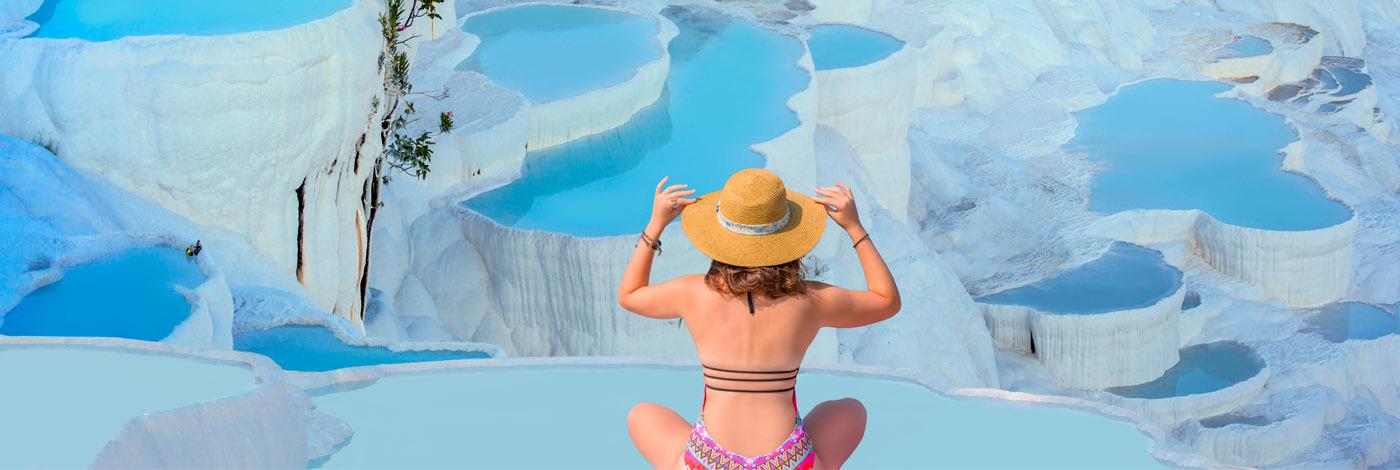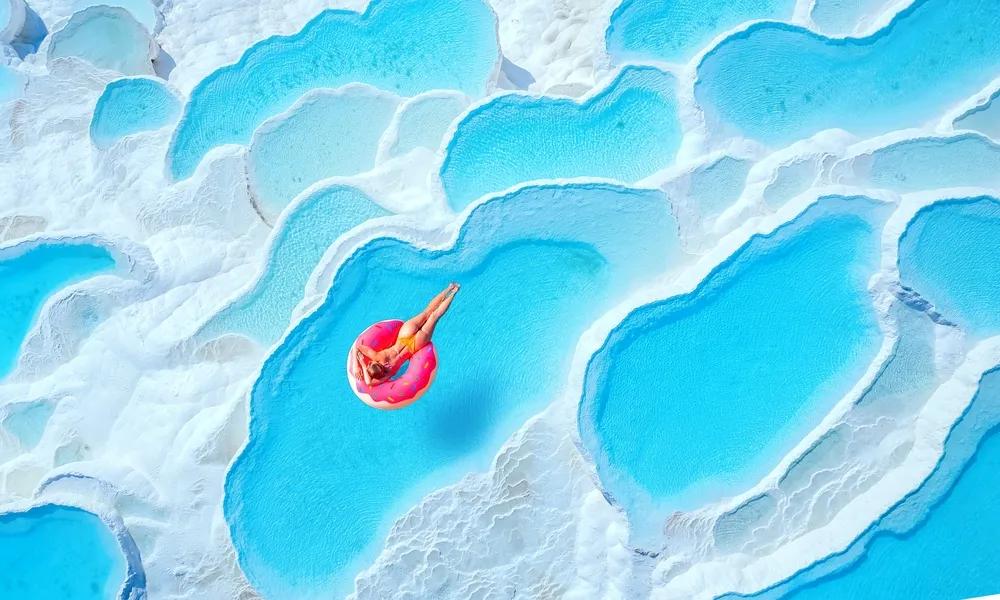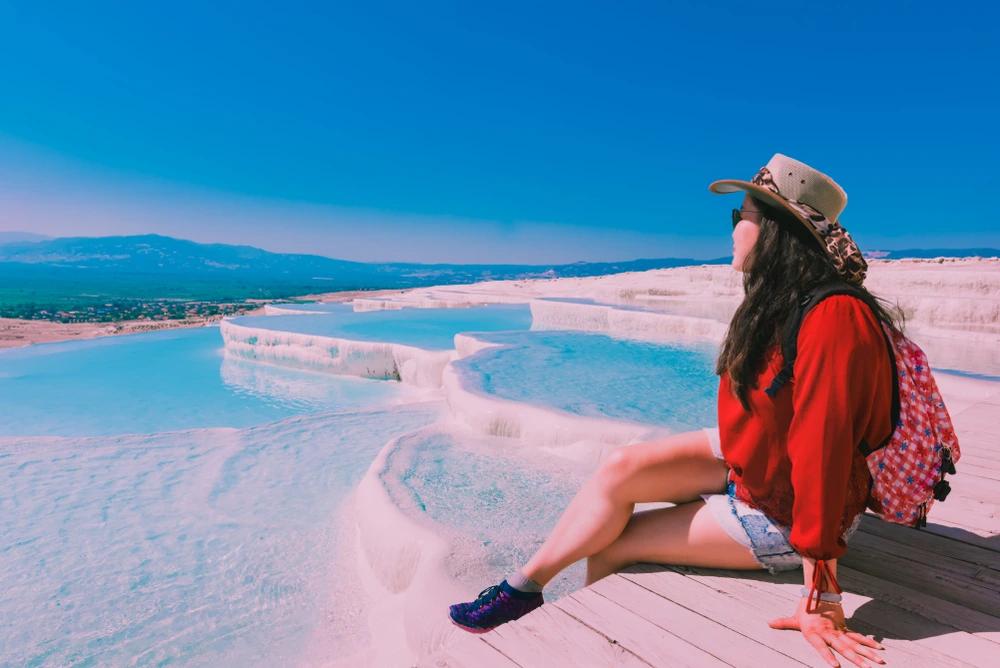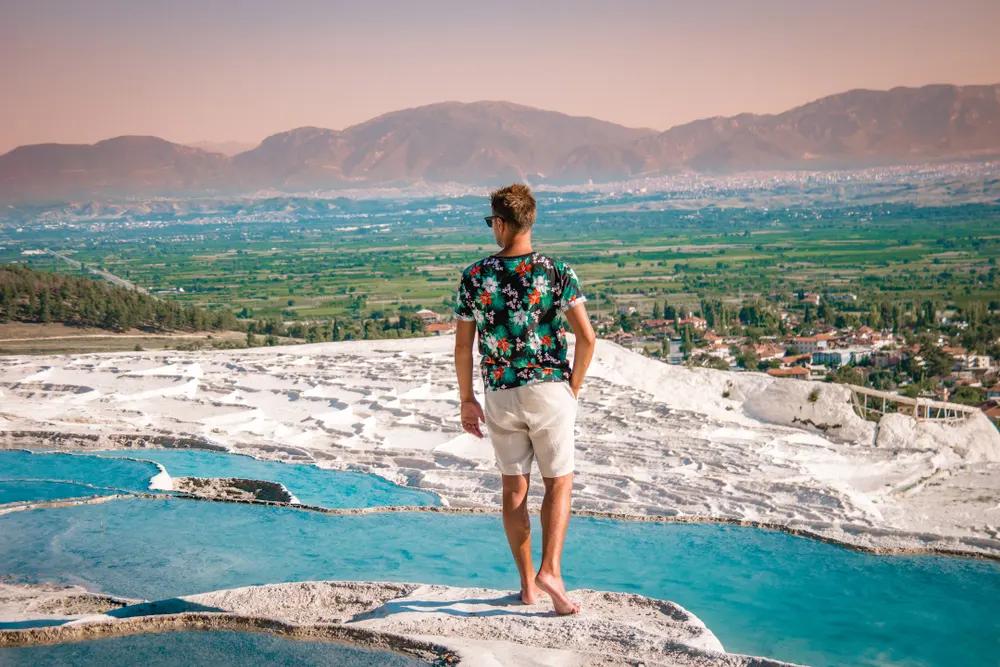
City of Pamukkale
The pools and calcium-filled travertines of Pamukkale are spectacular wondrous natural phenomena. It is one of the most awe-inspiring natural landscapes in the world. Every year, Pamukkale receives more than two million visitors. Surprisingly, that is more than any other tourist site in Turkey. Thousands of tourists pass through every day to marvel at the extraordinary sight.
The aptly-named town actually means “cotton castle”, which could not be a more accurate description. Pamukkale’s unique and whimsical terrain is formed by carbonate minerals deposited behind the flowing water. It is dotted with pure white travertine terraced pools tucked into the hillside—a truly breathtaking view. However, exactly how Pamukkale was created is not certain. Today, remains of the ancient city include temple ruins, functioning baths, a necropolis, and a gigantic theatre. Although it is a pretty small town, there is still a lot to see and do! Everything there is jam-packed and conveniently, within walking distance. The town was formed when a spring with a particularly high concentration of calcium bicarbonate cascaded over the mountain cliff, cooling, and hardening, and leaving brilliant white calcium deposits and aquamarine mineral-rich water.
The travertines filled with calcium cascade down almost 200 meters and have a resemblance to frozen waterfalls—truly a natural masterpiece. The travertines then pool down into the shallow natural spring basins. You can walk through them and feel the gentle warm embrace of the lapping water. Pamukkale and the ancient city and ruins of Hieropolis are official World Heritage Sites by UNESCO since 1988.
Once you visit and relish your eyes on one of the stunning natural landscapes on earth, you’ll understand why millions of visitors travel to Pamukkale. The thermal pools with their warm natural spring water continue to attract more and more tourists. Turkish people claim that taking a bath in these pools will cure all sorts of illnesses and ailments—from chronic disorders to eye and skin diseases. It’s for this reason that Pamukkale has been a thriving spa resort since antiquity. Legend has it that even Cleopatra herself bathed in these magical, healing pools. Aside from the wondrous healing properties of the water itself, the pools of Pamukkale are bordered by some seriously breathtaking ancient ruins and historical sites that you should not miss. At the very top of Pamukkale is the astounding ancient Greco-Roman city, Hierapolis, sort of crowning the cotton castle with a plethora of diving hot springs. The ancient city was turned into a sprawling spa in the 2 nd century B.C. It was transformed into a healing hub where doctors utilized the thermal springs’
healing properties for treatment for the sick. The city has a rich and colorful history.
Once upon a time, it was a very important religious epicenter after Emperor Constantine adopted Christianity and
established Constantinople, which is today Istanbul. A major earthquake shook the city in 17 AD and left it in complete ruins. The Romans later reconstructed it and even added a massive amphitheater. This surreal, picturesque town is located in South West Turkey, about 20 kilometers from the big town of Denizli. It is located in the Inner Aegean region of Turkey, in the River Menderes valley. The area has generally mild and pleasant temperatures for most of the year.
Visit Pamukkale and see the most beautiful destinations of Turkey Tours by clicking this link!
The primary point of entry is through Denizli, which connects all over turkey via bus, train, and plane. If you come by train or bus, you will have to go to the Denizli bus station’s lower level and look for the dolmus shuttle. The ride is only approxiametly 30 minutes to Pamukkale. It’s a convenient and inexpensive way to get there. As mentioned before, Pamukkale is a relatively tiny town so you will be able to navigate everything on foot easily. From Pamukkale, Hierapolis and the travertines are easily accessible by foot and Laodicea is easily reached by minibus. If you are considering visiting the neighboring Kaklik Cave or Aphrodisias you will have to arrange for either private or public transportation, depending on how adventurous you are feeling.
In the peak summer season from April to October, Pamukkale opens at 6 A.M and closed at 12 A.M. That gives you an 18-hour timeframe to explore the peculiar terrain. Just like with any other popular tourist attraction, it is critical that you arrive early when visiting. Since it can get really packed and chaotic, you will want some time to explore without having to worry about crowds and noise. The area is bustling with vendors, photographers, and lots of locals going to hang out.
There are many seaside resorts that have mass group tours that roll around at about 10 A.M, so if you get there early, you can avoid the mass crowds.
The water in the springs is pretty hot, so it can be used as a spa. Unfortunately, since the travertines have undergone severe damage from years of tourism, the stunning terraces are currently off-limits to preserve the ancient site. To not cause any further damage to their appearance, tourists will be asked to remove their shoes and follow a certain pathway, dotted with shallow pools where you can wade your feet as you traverse the travertines. Obviously, the best time to visit Pamukkale is during the summer, so you can fully enjoy the pools and bask in the fresh summer weather. The best time would be between April and June when the heat is not as intense and there are fewer crowds.

With so much to do and so much to see, you will easily spend a whole day visiting Pamukkale and exploring the ancient ruins of Hierapolis. You will find that you may spend less than an hour or so, exploring the terraces at Pamukkale. This is because they are only a handful of them and as it gets busier with more crowds during the day, it might get a bit unbearable. Once you get your proper dose of terraces, head over to Hierapolis for a retreat and journey full of splendor and exploration. You can easily spend a few hours there as you lose yourself in the whimsical remains of a splendid and grand past. You can also enjoy the hot spring or Cleopatra pools at the tippy top.
As mentioned above, Pamukkale was once an important spa city known for its healing, mineral-enriched water. Today, tourists still enjoy the splendid calcium-laden at the Antique Pool, also known as Cleopatra’s Pool because it is said that Marc Anthony gifted it to his lover, Cleopatra. What makes this gorgeous pool—lined with lush trees—unique are the marble columns that lay astray on its bottom. They date all the way back to the 2 nd century B.C and are actually the remnant of the nearby Temple of Apollo. The Romans once upon a time bathed in these very pools, you will find it quite a humbling and unreal experience to swim with the submerged ancient columns.
Immerse yourself in the pools of Pamukkale and many amazing places in Turkey Tours inside this link!

Be sure to head over to the Hierapolis Archaeology Museum if you are interested in archaeological artifacts or are a history buff. The museum is quite tiny. A tiny museum for a tiny town, how fitting. Located in a former Roman bath, it houses a wealth of historical artifacts from Hierapolis and Laodicea that would pique the curiosity of any tourist passing through. You will also find some interesting sarcophagi there.
If you are a real adventurous soul who enjoys adrenaline-pumping activities, then you should probably try paragliding or riding a hot air balloon over Pamukkale. It will offer a unique perspective from above that you just cannot get by walking through. Originating from spring on a 300-meter high cliff overlooking massive, sprawling plains, calcite-laden
water have created at Pamukkale a surreal landscape, dotted with mineral forest, petrified waterfalls
and an array of terraced basins.

